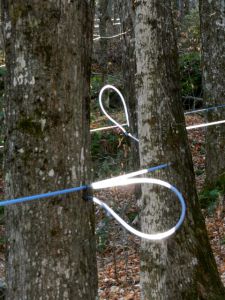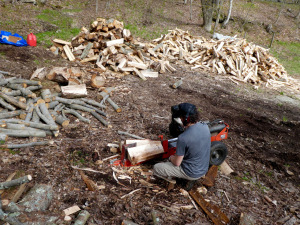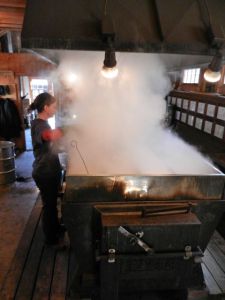







“Sugar season 2017 is officially over,” declared Chief of Operations on Sunday.
A Look Back: As always happens, we learned that our season was similar to that of sugarers on the other side of Mt. Mansfield and in the rest of our county, Lamoille County. Some made syrup in January (not, and probably never, us). Everyone made a lot of syrup in February, relatively little in March, and we all ended the season with a whopper of a run ca. April 8-11. Was it a good year? Yes, we nod, but not as good as last year. What about grade? Well, for us it was the Year of Light Amber Rich; I can’t speak for others.
Did we break any of our records? Yes, in two categories.
2017 beat out 2016 by one day in the category “Longest Season” which we measure as the first through the last day of boiling. The dates? February 20 – April 11 for a total of 51 days.
2017 also beat out 2016 by five days in the category “Earliest Start.” This year, February 20; last year, February 25.
For me it takes some of the fizz out of the experience to compare Nebraska Knoll’s season with that of other sugarmakers. When someone asks “How was your season?”, all the uncertainty, the waiting, the worry, the adrenaline rushes, the pots of coffee, the giggling fits, the syrup spills, the filter press woes, the bass beat emanating rom the boom box, the stoking gloves wrapped in duct tape, the sagging faces of the stokers, the filthy ash-cleaning wool hat hanging on its peg, the aroma of ham and scalloped potatoes, the play within this play called Waiting for Lorenzo, the steam, the clank of the stovebox door being jerked open, and the sticky rooster-shaped timer set at 8 minutes between stokes – all as ephemeral as the spring beauties – reside within my response “It was good.”
It was very good.
Now, dear readers, the long-like-this-season phase of the blog ends, but the blog door stays ajar. Thanks for clicking or tapping this way, and as I have said other years, “For goodness sake turn off those marvelous digital devices and get outside.”
Blog Staff:
Photography: Chief of Operations
Food correspondent: Maple Trout Lilli
Artist in residence: Ana Lucia Fernandez
Contributing photographers: Tom and Laurie Silva and the crew
Contributing writers: Sarah Bailey, Joe Renish, Chief of Operations
Supporting Cast: The Crew
Senior Editor: AC



